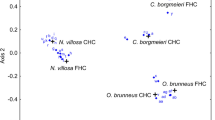Abstract
Vespine wasps have been shown to deposit an attractive chemical in the nest entrance. Foragers use this to help locate the nest when returning to it. We determined how many individuals need to track (pass through) the entrance before the chemical is recognized. We found a logistic response as the number of tracks increased. At 200 tracks and above there was a 75–90% positive response rate to the chemical. We found no evidence of trail-marking behavior performed by foragers inside the nest entrance. We conclude that the trail is not an evolved signal, but is a cue composed of an accumulation of hydrocarbons deposited from the legs or feet of workers as they walk on a substrate. This is the first quantitative measurement of the attractiveness of the nest-entrance chemical in a social wasp.

Similar content being viewed by others
References
Akre RD, Garnett WB, MacDonald JF, Greene A, Landolt P (1976) Behavior and colony development of Vespula pensylvanica and V. atropilosa (Hymenoptera: Vespidae). J Kans Entomol Soc 49:63–84
Anzenberger G (1986) How do carpenter bees recognize the entrance of their nests? An experimental investigation in a natural habitat. Ethology 71:54–62
Butler CG, Fletcher DJC, Watler D (1969) Nest-entrance marking with pheromones by the honeybee—Apis mellifera L., and by a wasp, Vespula vulgaris L. Anim Behav 17:142–147
Cammaerts M-C, Cammaerts R (2001) Marking of nest entrances and vicinity in two related Tetramorium ant species (Hymenoptera: Formicidae). J Insect Behav 14:247–269
Cederberg B (1977) Evidence for trail marking in Bombus terrestris workers (Hymenoptera, Apidae). Zoon 5:143–146
Foster RL, Gamboa GJ (1989) Nest entrance marking with colony specific odors by the bumble bee Bombus occidentalis (Hymenoptera: Apidae). Ethology 81:273–278
Hefetz A (1992) Individual scent marking of the nest entrance as a mechanism for nest recognition in Xylocopa pubescens (Hymenoptera: Anthophoridae). J Insect Behav 5:763–772
Hölldobler B, Wilson EO (1990) The Ants. Belknap, Cambridge, Mass.
Jeanne RL (1981) Chemical communication during swarm emigration in the social wasp Polybia sericea (Olivier). Anim Behav 29:102–113
Landolt PJ, Jeanne RL, Reed HC (1998) Chemical communication in social wasps. In: VanderMeer RK, Breed MD, Espelie KE, Winston ML (eds) Pheromone Communication in Social Insects. Westview Press, Boulder, Colo., pp 216–235
Lloyd JE (1983) Bioluminescence and communication in insects. Annu Rev Entomol 28:131–160
Seeley TD (1989) The honey bee colony as a superorganism. Am Sci 77:546–553
Steinmetz I, Schmolz E (2003) Use of terrestrial chemical trails for nest orientation in an open nesting wasp, Dolichovespula saxonica F. Insectes Soc 50:292–294
Steinmetz I, Sieben S, Schmolz E (2002) Chemical trails used for orientation in nest cavities by two vespine wasps, Vespa crabro and Vespula vulgaris. Insectes Soc 49:354–356
Steinmetz I, Schmolz E, Ruther J (2003) Cuticular lipids as trail pheromone in a social wasp. Proc R Soc Lond Ser B 270:385–391
Acknowledgements
We thank Peter and Jennifer Zeimet and Melissa Dalton for allowing us to excavate yellowjacket nests from their lawns. We are grateful to Mark Allington for constructing nest boxes and testing apparatus. We appreciate Reid Maier, Lucas Rifkin, and Ken Howard for their help in collecting and setting up nests. We thank Andy Bersch and Erik Iverson for help with statistical analyses. Research supported by Hatch grant no. 4433 to R. L. J. and by the College of Agricultural and Life Sciences, University of Wisconsin–Madison. Experiments in this study comply with the current laws of the United States of America.
Author information
Authors and Affiliations
Corresponding author
Rights and permissions
About this article
Cite this article
Jandt, J.M., Curry, C., Hemauer, S. et al. The accumulation of a chemical cue: nest-entrance trail in the German yellowjacket, Vespula germanica. Naturwissenschaften 92, 242–245 (2005). https://doi.org/10.1007/s00114-005-0613-5
Received:
Accepted:
Published:
Issue Date:
DOI: https://doi.org/10.1007/s00114-005-0613-5




